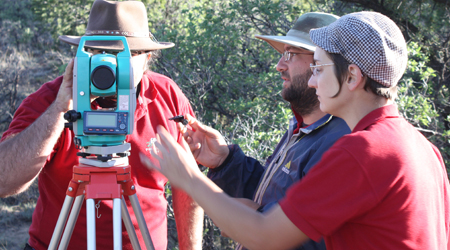
Archaeology Students Complete Field School at Philmont Ranch
New Mexico Highlands University archaeology students completed a summer field school using new, cutting-edge mapping equipment in a limited-access site rich in ancient Native American artifacts.
The Boy Scouts of America own the site’s property, Philmont Ranch, which covers approximately 215 square miles of rugged wilderness in the Sangre de Cristo Mountains of northern New Mexico near Cimarron.
“This was an amazing opportunity for my graduate students to do field research, and they discovered hundreds of artifacts that will help tell the story of the native peoples who once populated this land from about A.D. 300 to 800,” said anthropology professor Warren Lail, who worked alongside the students at the field school. “Artifacts left in the ground serve as missing pieces of a complex puzzle that we need to assemble in order to explain the lives of these now extinct cultures.”
Lail said the students learned how to map sites using a high-tech device called a total station, which the university purchased in 2009. The equipment is mounted on a tripod, and records three-dimensional information that is then fed into a software program to generate shaded relief maps. Before this technology was available, archaeology students prepared site maps by hand.
Lail said during the intensive four-week field school, his students learned to locate archaeological sites, to excavate them, and to collect and analyze their data.
“I am extraordinarily impressed with the quality of my students at Highlands,” said Lail, who joined the university’s faculty in 2008.
Lail earned both his doctoral and master’s degrees in archaeology from the University of Oklahoma. He did field work at the Philmont Ranch and surrounding areas for his dissertation, where he built strong working relationships with area landowners.
“Philmont’s management team understands our research objectives, and they are very supportive,” Lail said. “The goal is that this first Highlands field school will lead to a long-term partnership between NMHU anthropology and the Philmont Ranch. Already, four NMHU graduate students are doing M.A. research there.”
Lail has had an unusual career path.
“I earned a bachelor’s degree in anthropology from the University of North Carolina at Chapel Hill,” Lail said. “Then I decided to go to law school because I was interested in legal anthropology.”
After earning his law degree from Wake Forest University and passing the bar exam, Lail practiced law for nine years, specializing in banking law.
“Banking law is a bit dry, and, after working 65 hours a week for so many years, I thought about what I originally set out to do, and about what excited and motivated me,” Lail said. “I sold my law practice and decided to focus on archaeology rather than legal anthropology. Imagine what a pleasure it is for me to lecture about what I love and not have someone from across the room stand and shout, ‘I object’.”
Adam Fuselier is one of Lail’s graduate students who appreciates his professor’s passion for archaeology. He participated in the Philmont field school.
“For me the most valuable part of the Philmont field school was the chance to learn how to use the total station mapping technology,” Fuselier said. “My ultimate goal is to be a supervisory archaeologist in a cultural resources management firm. Learning this technology gives me an edge when I finish my master’s degree and try to get a job.”
Lail said the university is committed to adding resources for the anthropology program, including building a new 850-square-foot archaeology lab in the Lora Shields building. The university will also build a climate-controlled artifact storage area in the building’s basement.
“In an area as rich in archaeological resources as northern New Mexico, we want to be at the very forefront of the discipline right here at Highlands University,” Lail said. “We want our university to be a destination for students interested in studying the archaeology of the American Southwest.”
